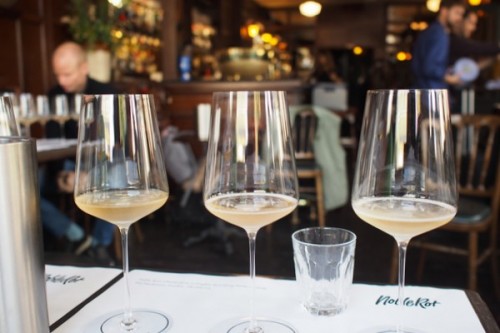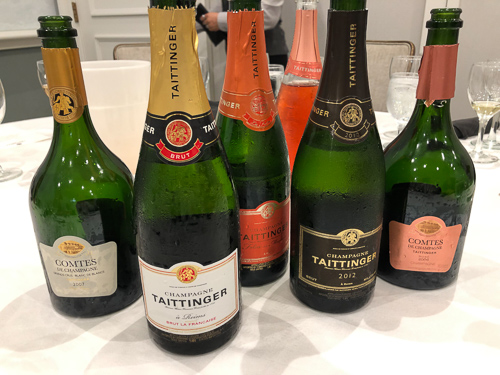
I mentioned a while back that I’d taken part in a tasting of English sparkling wine versus Champagne. Organized by counter-culture wine publication Noble Rot, it pitted a carefully selected quartet of English fizz against four very good grower Champagnes, and four very good Grand Marque Champagnes. It was a fair fight: all three quartets had been well chosen, and there was a ceiling on price, so like was facing like.
The tasters were an eclectic bunch, including some very fine wine palates, but also some gastronomically fine non-wine palates. For full details, read the next edition of Noble Rot, which will be mailed early next week. The Telegraph jumped the gun a bit and published the results ahead of the embargo, which is why I’m not linking to the article here – nor have I given it social media love (for the record, this isn’t the fault of their excellent wine writer).

The big headline? When the results of all the tasters was totted up, English wines occupied spots 1 and 2. That’s a striking result. As a fan of English sparkling wines – it’s a sector I’m really excited about – this is a great result. But I’d urge a little caution here: in the tasting some of the non-sparkling wine specialists were giving scores with a crazy range, which could hit some of the wines hard. We were asked to score out of 20, and some were giving some of the wines low single-digit scores (even one of the wine specialists did this). This is nuts: this is a really strong line-up of wines. I think it’s because less experienced tasters score hedonically (how much do I like this?) rather than for quality (I may not like the style, but this is a really good example).

So I thought it might be useful to publish my own blind scores and notes (unedited, save for a tiny bit of tidying up). As well as scoring out of 20 for official purposes, I also scored out of 100. Below my scores, I’ve published the official results. Here we have my ranking, the tasting note, and in brackets the group ranking.
1 Champagne Taittinger NV France
Linear and pure with fine citrus, pear and white peach. Impeccable balance here, showing subtle toastiness and lovely citrus fruit. Very pure and refined: stylish stuff. 94/100 (group position 4)
2 = Gusbourne 2010 England
Very appley, distinctive and pretty. Open and a bit toasty with lovely depth of flavour: pear, apples, spices and fine fruitiness. Quite light but just so distinctive. 93/100 (group position 9)
2= Champagne Chartogne-Taillet Sainte Anne NV France
Open , quite appley nose with a hint of herbs. Tight, lean and focused on the palate with some appley, slightly oxidative notes and keen citrus fruit. Lovely complexity and harmony with a long finish. Beautiful. 93/100 (group position 10)
4= Champagne Marguet Cru Extra Brut NV France
Superbly balanced. Subtle toasty notes and a bit of appley richness on the nose, with nice lemony fruit. Really elegant and refined with fine bready toasty notes and some subtle oxidative characters. Very fine. 92/100 (group position 8)
4= Nyetimber Classic Cuvée 2010 England
Very refined and fine. Subtly toasty with attractive pear, peach and citrus fruit. Linear and precise: a really pretty wine. 92/100 (group position 2)
6= Champagne Frerejean Freres Brut NV France
Complex toasty nose with nice savoury, nutty hints. The palate has lovely fruitiness combines with honey, toast and pear. Broad and stylish with nice richness. 91/100
6= Champagne Pol Roger NV France
Lemony and crisp with bright apple and pear fruit. Lovely lemony focus here, showing precision and purity. There’s a touch of sweetness. So focused yet has a little richness. Pure. 91/100
8= Champagne Bereche Brut Reserve NV France
Faint pink edge to the colour. Taut, citrussy and lively nose is quite shy. Lively appley palate with citrussy acidity. Lemony and quite structured with a savoury, dry character. Still youthful. 90/100
8= Wiston Cuvee NV England
Very lively, complex and citrussy with a distinct toastiness and high acidity. A real mouthful: intense, primary, linear and quite pretty, but just so youthful and intense. 90/100
10 Champagne Veuve Cliquot Brut NV France
Lively and bright with lovely lemony fruit and a bit of toastiness. There’s a sweet core of pear and apricot. Rich and balanced, this is a crowd pleaser with lovely harmony. 89/100
11= Hambledon NV England
Some creamy/dairy notes on the nose. Sweet, lively and fresh with keen lemony acidity. Very bright and quite tart with precise, intense lemony character. Linear and pure. 88/100
11= Champagne Savart L’Ouverture NV France
Extremely appley, oxidative nose of lemons, baked apples and pears. The palate is concentrated, fresh and appley with crisp fruit. Linear and distinctive in an oxidative style. Complex and broad: maybe too oxidative? 88/100
Overall results
- Hambledon Classic Cuvee (ENGLISH): 178.5
- Nyetimber Classic Cuvee 2010 (ENGLISH): 175
- Pol Roger Brut Reserve (FRENCH): 173.5
- Taittinger Brut Reserve (FRENCH): 173
- Bereche Brut Reserve (FRENCH): 167
- Wiston Cuvee (ENGLISH): 166.5
- Frerejean Freres Brut (FRENCH): 165.5
- Marguet Cru Extra Brut (FRENCH): 164
- Gusborne Brut Reserve 2010 (ENGLISH): 160.4
- Chartogne-Taillet Sainte Anne (FRENCH): 160
- Veuve Cliquot Brut Yellow Label (FRENCH): 159.5
- Savart L’Ouverture (FRENCH): 150.5
Note added later: the full report in Noble Rot is now available here
3 Comments on English sparkling wine versus Champagne – the Noble Rot tasting – my results
Would maybe question the representativeness of this Savart. Would not put his wine in the oxidative style camp. I agree with your commentary on scoring by many people that can’t put aside their stylistic preference or preconceived idea of what champagne must be in style and judge the intrinsic quality and the lack of their consistency, precision, relativity in their scoring. What was the criteria for selection of cuvees tasted? The French ones are entry level cuvees for all the Houses chosen. All that said it is encouraging to see the English sparkling wines on the rise in quality.
Actually Jamie suggested that ‘stylistic preference’ might be a reason for low scores – not that it was. You’d need to ask the low scorers about that and it doesn’t look like he did.
Equally of course, the non-experts could give high marks for the same reason – no complaints about that is there?
Sounds like it was a great tasting. I am confident that English sparkling wine will continue to improve, giving Champagne a run for it’s money.